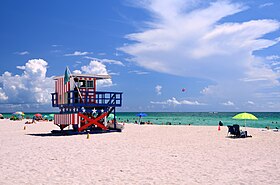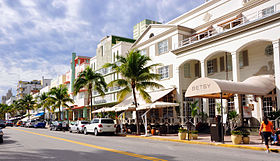
Back مقاطعة ميامي داد (فلوريدا) Arabic Condáu de Miami-Dade AST Beziak Miami-Dade BAR Маями-Дейд (окръг, Флорида) Bulgarian মায়ামি-ডেইড কাউন্টি, ফ্লোরিডা BPY Comtat de Miami-Dade Catalan Miami-Dade Gông (Florida) CDO Майами-Дейд (гуо, Флорида) CE Miami-Dade County CEB Miami-Dade County, Florida Welsh
Miami-Dade County | |
|---|---|
|
Left to right from top down: Downtown Miami Skyline; a lifeguard station on South Beach; South of 15th Street on Ocean Drive (South Beach); Venetian Pool in Coral Gables; Anhinga Trail boardwalk in Everglades National Park; Kaseya Center on Biscayne Boulevard; and an aquatic reef in Biscayne National Park | |
| Nicknames: "Dade County", "Dade", "Metro-Dade", "Greater Miami" | |
| Motto: Delivering Excellence Every Day | |
 | |
| Coordinates: 25°36′38″N 80°29′50″W / 25.61058°N 80.497099°W[1] | |
| Country | |
| State | |
| Region | South Florida |
| Metro area | Miami |
| Founded | February 4, 1836 |
| Named for | Francis L. Dade and Miami, derived from the Miami River, and ultimately derived from Mayaimi |
| County seat and largest city | Miami |
| Incorporated municipalities | 34 |
| Government | |
| • Type | Two-tier federation |
| • Body | Miami-Dade Board of County Commissioners |
| • County Commission[2] | Commissioners
|
| • Mayor | Daniella Levine Cava (D)[a] |
| Area | |
• Total | 2,431.178 sq mi (6,296.72 km2) |
| • Land | 1,898.753 sq mi (4,917.75 km2) |
| • Water | 532.425 sq mi (1,378.97 km2) 21.9% |
| Highest elevation | 20−25 ft (6–8 m) |
| Lowest elevation | 0 ft (0 m) |
| Population | |
• Total | 2,701,767 |
• Estimate (2023)[5] | 2,686,867 |
| • Rank | 7th in the United States 1st in Florida |
| • Density | 1,100/sq mi (430/km2) |
| Demonym | Miamian[6] |
| GDP | |
| • Total | $239.652 billion (2023) |
| Time zone | UTC−5 (Eastern Time Zone) |
| • Summer (DST) | UTC−4 (Eastern Daylight Time) |
| ZIP Codes | 33002, 33010–33018, 33030–33035, 33039, 33054, 33056, 33090, 33092, 33101–33102, 33106, 33109, 33111–33112, 33114, 33116, 33119, 33122, 33124–33147, 33149–33158, 33160–33170, 33172–33199, 33206, 33222, 33231, 33233–33234, 33238–33239, 33242–33243, 33245, 33247, 33255–33257, 33261, 33265–33266, 33269, 33280, 33283, 33296, 33299 |
| Area codes | 305, 786, 645 |
| FIPS code | 12086 |
| GNIS feature ID | 295755 |
| Website | miamidade |
Miami-Dade County (/maɪˈæmi ˈdeɪd/) is a county located in the southeastern part of the U.S. state of Florida. The county had a population of 2,701,767 as of the 2020 census,[4] making it the most populous county in Florida and the seventh-most-populous county in the United States.[8] It is Florida's third largest county in terms of land area with 1,946 square miles (5,040 km2). The county seat is Miami, the core of the nation's ninth-largest and world's 65th-largest metropolitan area with a 2020 population of 6.138 million people, exceeding the population of 31 of the nation's 50 states as of 2022.[9]
As of 2022, Miami-Dade County has a gross domestic product of $184.5 billion, making the county's GDP the largest for any county in the State of Florida and the 14th-largest for the nation's 3,033 counties.[10][11] The county is home to the Port of Miami on Biscayne Bay, the world's largest passenger port with a world record 5.5 million passengers in 2018, and Miami International Airport, the third largest U.S. airport for international passengers and largest U.S. airport for international cargo. The county's land area of nearly 2,000 square miles exceeds that of two U.S. states, Delaware and Rhode Island.[12] The county is home to several universities and colleges, including Florida International University, one of the largest public universities in the country, and the University of Miami in Coral Gables, a private research university that is routinely ranked as one of the nation's top universities and is the county's second-largest employer with nearly 17,000 employees as of 2021.[13][14]
Miami-Dade County is heavily Hispanic and is the most populous majority-Hispanic county in the nation as of 2020. It is home to 34 incorporated cities and many unincorporated areas.[15] The northern, central and eastern portions of the county are heavily urbanized with many high-rise buildings along the coastline, including Miami's Central Business District in downtown Miami. Southern Miami-Dade County includes the Redland and Homestead areas, which make up the agricultural economy of the county. Agricultural Redland makes up roughly one third of Miami-Dade County's inhabited land area, and is sparsely populated, a stark contrast to the densely populated, urban portions of the county's northern sections.
The county includes portions of two national parks. To the west, the county extends into Everglades National Park and is populated only by a Miccosukee tribal village. Biscayne National Park and the Biscayne Bay Aquatic Preserves are located east of the mainland in Biscayne Bay.[16][17]
- ^ "Counties Gazetteer" (TXT). 2.census.gov. Retrieved February 2, 2022.
- ^ "Agencies and Officials". 8.miamidade.gov. Archived from the original on November 8, 2018. Retrieved November 12, 2018.
- ^ "Miami-Dade County High Point - Peakbagger.com". Peakbagger.com.
- ^ a b "P2: HISPANIC OR LATINO, AND NOT ... - Census Bureau Table". P2 | HISPANIC OR LATINO, AND NOT HISPANIC OR LATINO BY RACE. U.S. Census Bureau. Retrieved March 21, 2023.
- ^ "County Population Totals and Components of Change: 2020-2023". County Population Totals: 2020-2022. U.S. Census Bureau. Retrieved September 9, 2024.
- ^ "How Do You Know If You're a Real Miamian?". miaminewtimes.com.
- ^ "Gross Domestic Product: All Industries in Miami-Dade County, FL". fred.stlouisfed.org.
- ^ "MiamiHerald.com". Miami Herald.
- ^ "Find a County". National Association of Counties. Retrieved June 7, 2011.
- ^ "Gross Domestic Product by County and Metropolitan Area, 2022" (PDF). www.bea.gov. Bureau of Economic Analysis.
- ^ Federal Reserve Bank of St. Louis: Real Gross Domestic Product: All Industries in Miami-Dade County, FL. Accessed June 15, 2024.
- ^ "About Miami-Dade County", Miami Dade County website, accessed February 10, 2023
- ^ University of Miami profile at U.S. News & World Report National Universities
- ^ "Largest employers in South Florida", South Florida Business Journal, September 24, 2021
- ^ "Miami-Dade County Municipalities". www8.miamidade.gov. Archived from the original on February 21, 2019. Retrieved May 22, 2022.
- ^ "Biscayne Bay Aquatic Preserves | Florida Department of Environmental Protection". floridadep.gov.
- ^ "Biscayne Bay Aquatic Preserve". Florida Department of Environmental Protection. July 8, 2015. Retrieved December 14, 2015.
Cite error: There are <ref group=lower-alpha> tags or {{efn}} templates on this page, but the references will not show without a {{reflist|group=lower-alpha}} template or {{notelist}} template (see the help page).









